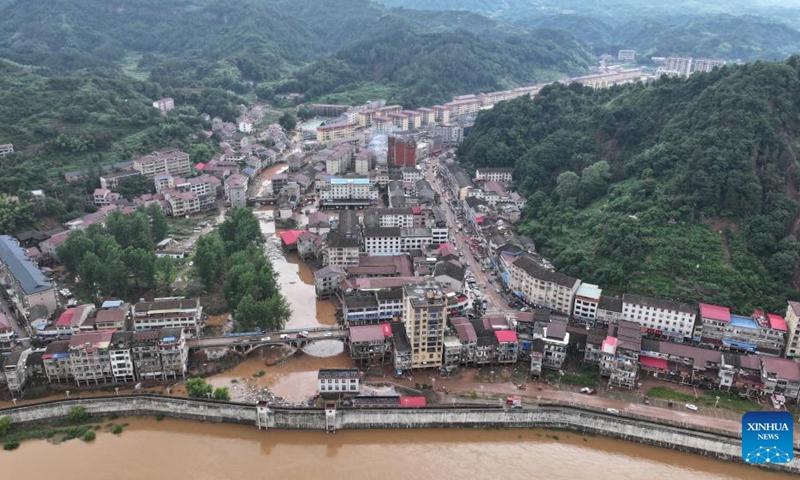
An aerial drone photo taken on June 23, 2024 shows Wuqiangxi Township of Yuanling County in central China's Hunan Province. Heavy rainfall hit Wuqiangxi Township on Saturday, triggering flood that impacted local residential area. Local authorities have carried out emergency response to minimize the impact of the extreme weather conditions. (Photo: Xinhua)
China's National Meteorological Center (NMC) issued 2024's first red alert, the highest level, for rainstorms on Monday morning, as the southern part of the country, particularly the middle and lower reaches of the Yangtze River, has been soaked in torrential rainstorms since mid-June, posing great inconvenience to local people and risking their lives and property.
Torrential downpours have been continuing in the middle and lower reaches of the Yangtze River since June 17, with multiple places, including East China's Anhui, Zhejiang and Jiangxi provinces, as well as Central China's Hubei and Hunan provinces, being hit by rainstorms with accumulated precipitation of 200 millimeters to 400 millimeters. Particularly, the rainfall in Changde in Hunan and Huangshan in Anhui has even reached 500 to 713 millimeters.
The NMC forecasted that the core area of precipitation will continue to reach from the middle and lower reaches of the Yangtze River to the northern part of the coastal area south of the Yangtze River over the next three days, with intense downpours in some areas.
Additionally, extraordinary rainstorms with precipitation of 250 millimeters to 270 millimeters are expected in the southern part of Anhui, the northeastern part of Jiangxi and the western part of Zhejiang from Monday afternoon to Tuesday afternoon. The maximum hourly precipitation could reach up to 70 millimeters in some areas.
In Changsha, Hunan Province, the hourly rainfall reached 65.1 millimeters at a rainfall station on Monday morning, breaking the local record for hourly rainfall in June. The total precipitation in one hour in Changsha amounted to 768 million cubic meters, which was approximately equivalent to 54 West Lakes.
Online video clips showed that floodwaters marooned vehicles on streets and poured into a subway station on Monday. The metro operator in Changsha announced around noon on Monday that Changsha's metro Line 2 and Line 3 had suspended operations due to the heavy rain.
Many netizens commented that if the downpours in Changsha continue, people will have to use boats to get around the city.
A clothes shop owner in Changsha told the Global Times on Monday that the wholesale market where her shop is located flooded on Monday, but fortunately, she had moved all her inventory out of the shop the previous night.
Due to the impact of the rainstorm, multiple local hydrological bureaus in cities across Hunan have issued flood alerts. According to forecasts, heavy rain will continue in most parts of Hunan.
The weather forecast predicted that from Tuesday to Thursday, heavy rainfall will be concentrated in northern and central Hunan. From Friday to Sunday, the rain will gradually move southward. In the coming week, northern and central Hunan will experience continuous rainstorms, with some areas facing extremely heavy torrential rainfall.
Apart from the rain-soaked Changsha, the West Lake and the famous Lingyin Temple in Hangzhou, East China's Zhejiang Province, also became hot topics on China's X-like social media platform Sina Weibo on Monday.
Due to the continuous rainfall during the "plum rain" season, the water level of West Lake has been continuously rising. The lake exceeded the 7.3 meters warning level on Sunday morning. Starting midnight Saturday, the West Lake began discharging water into the local rivers. As of Sunday night, a total of 1.32 million cubic meters of water had been discharged, however, the lake's water levels still exceeded the warning level.
According to Jiang Zhijian, head of the information data department at the West Lake management office, the last time the water level of West Lake exceeded warning levels was about two or three years ago and that such situations are usually caused by typhoons or short, heavy rainfalls, as reported by Zhejiang Radio and Television Group's Economic Life Channel.
Additionally, due to the heavy rains on Sunday, several famous tourist attractions in Hangzhou, such as the Nine Creeks and Eighteen Gullies, were impacted or closed, according to media reports.




